#up 25 april coronavirus news
Explore tagged Tumblr posts
Text
A Minnesotan Sizes Up Tim Walz
During his tenure, student achievement has slipped, crime has surged, and state residents have fled.
By Scott W. Johnson - Wall Street Journal
St. Paul, Minn.
Tim Walz has such a bad record as Minnesota’s governor that I was astonished when he landed on Vice President Kamala Harris’s vice-presidential shortlist. As Minnesota’s Center of the American Experiment has documented, under Mr. Walz Minnesota has become a high-crime state. Student achievement has tumbled as spending on schools has skyrocketed. Per capita gross domestic product has fallen below the national average. Minnesotans have joined residents of New York, California and Illinois in fleeing their home state.
Pennsylvania Gov. Josh Shapiro—also on Ms. Harris’s shortlist—made sense to me. Pennsylvania is a key state. Mr. Shapiro seems to be a man of substance and would give liberal Jews a reason to vote for Ms. Harris without a guilty conscience. As a Jewish supporter of Israel, I worried that Mr. Shapiro would give the animus throbbing in the heart of the Democratic Party cover. Indeed, that animus drove a nasty intraparty campaign against him.
But Tim Walz? I’m a conservative Republican. I don’t completely understand Democrats’ ways. As an observer of Minnesota politics, however, I understand how Mr. Walz became governor. Having served six terms in Congress from a rural district, he challenged the endorsed DFL (Democratic-Farmer-Labor Party) candidate—a liberal metro-area state senator, Erin Murphy—in the 2018 DFL primary. Ms. Murphy was also challenged by another metro-area liberal, Lori Swanson, then state attorney general. With Ms. Murphy and Ms. Swanson dividing the liberal urban vote, Mr. Walz and his far-left running mate, former state Rep. Peggy Flanagan, won the primary with 41%.
On taking office in 2019, Gov. Walz was restrained by a one-seat Republican majority in the state Senate—until Covid hit in the spring of 2020. He declared a state of emergency on March 25, 2020, and ruled by decree for 15 months. He proclaimed the emergency on the basis of an allegedly sophisticated Minnesota Model projection of the virus’s course in the state. In fact, the projection reflected a weekend’s work by graduate students at the University of Minnesota School of Public Health. Relying on their research, Mr. Walz presented a scenario in which an estimated 74,000 Minnesotans would perish from the virus. The following week the Star Tribune reported that with the lockdown Mr. Walz ordered, 50,000 would die. Maybe it would have been preferable to address the virus through democratic means.
Having destroyed jobs and impeded life routines, including family get-togethers and church attendance, Mr. Walz finally let his one-man rule lapse on July 1, 2021. When the Johns Hopkins Coronavirus Resource Center stopped counting in March 2023, the deaths of 14,870 Minnesotans were attributed to the virus. (In 2020 I successfully sued the administration for excluding me from Health Department press briefings on Covid.)
During the state of emergency, protests broke out in Minneapolis on Memorial Day 2020 following the death of George Floyd. That Thursday, rioters burned Minneapolis’s Third Precinct police station to the ground. Mr. Walz didn’t deploy the National Guard until the weekend. Riots, arson and looting throughout the Twin Cities caused about $500 million in damage.
Minnesota leads the nation in Covid fraud. Under the auspices of the Feeding Our Future nonprofit, its founder, Aimee Bock, allegedly recruited mostly young Somali men to seek reimbursement for millions of meals supposedly served to poor students and families. According to indictments handed up by a grand jury to U.S. Attorney Andrew Luger, Ms. Bock and others allegedly defrauded the state and federal government of $250 million. Ms. Bock has pleaded not guilty to the fraud charges.
Among the 70 defendants charged to date, 18 have pleaded guilty. In April the first of the cases to go to trial had seven defendants; five were convicted. The remaining cases have yet to be tried. In all, the Minnesota Department of Education oversaw the payout of $250 million to reimburse fictitious meals. The nature and scale of the fraud are staggering. Mr. Walz tried to blame state district court judge John Guthmann, who in April 2021 handled a case regarding the department’s processing of applications for reimbursements. According to Mr. Walz, Judge Guthmann ordered the state to continue payouts to the alleged perpetrators of the fraud even after the state Education Department discovered it.
In September 2022, Judge Guthmann authorized a news release titled “Correcting media reports and statements by Gov. Tim Walz concerning orders issued by the court.” The release concluded: “As the public court record and Judge Guthmann’s orders make plain, Judge Guthmann never issued an order requiring the MN Department of Education to resume food reimbursement payments to FOF. The Department of Education voluntarily resumed payments and informed the court that FOF resolved the ‘serious deficiencies’ that prompted it to suspend payments temporarily. All of the MN Department of Education food reimbursement payments to FOF were made voluntarily, without any court order.”
In November 2022 Mr. Walz was elected to a second term, and the DFL won majorities in both chambers of the Legislature. In the preceding two years the state had accumulated an $18 billion budget surplus. With the DFL in full control, Mr. Walz and the Legislature have spent the $18 billion surplus on infrastructure, education and other programs that will burden the state for years. They have also raised taxes.
Mr. Walz and his DFL colleagues have backed measures establishing Minnesota as a mecca for abortion and a “trans refuge.” The legislation prohibits enforcing out-of-state subpoenas, arrest warrants and extradition requests for people from other states who seek treatment that is legal in Minnesota. It also bars complying with court orders issued in other states to remove children from their parents’ custody for authorizing hormone treatment or surgery to alter sex characteristics.
Like so many Democrats who have kept up with the demands of the progressive agenda, Mr. Walz has “grown” in office. In his second term, he has been the most left-wing Minnesota governor since the socialist Floyd B. Olson (1931-36). I doubt that Mr. Walz could be elected to Congress in his old district, which is now represented by a Republican. The idea that he can appeal to voters who don’t already support Ms. Harris seems far-fetched.
Mr. Johnson is a retired Minneapolis attorney and contributor to the site Power Line.
#Tim Walz#minnesota#Democrats#kamala harris#Obama#Biden#Corrupt#trump#trump 2024#president trump#ivanka#donald trump#america#americans first#america first#repost#corruption kink#government corruption#democrats are corrupt#biden corruption#impeach#maga
77 notes
·
View notes
Text

Stolen van Gogh Painting Worth Millions Returned in a Ikea Bag
The painting was stolen in March 2020 from the Singer Laren Museum.
A Dutch art detective has helped recover a missing Vincent van Gogh painting that was stolen from the Singer Laren Museum, east of Amsterdam, in March 2020.
The "Parsonage Garden at Nuenen in Spring," painted in 1884, was stolen from the famous Dutch museum in a daring overnight smash-and-grab heist during the coronavirus lockdown.
Dutch art crime detective Arthur Brand, who has spent decades tracking down some of the world's greatest masterpieces, announced on Tuesday he had recovered the stolen masterpiece.
In a video posted on Brand's Instagram, the detective can be seen unwrapping the coveted artwork, holding it up as he poses for the camera.

"So here it is! The Spring Garden by Vincent van Gogh which was stolen three and a half years ago on Van Gogh's birthday from a museum in the Netherlands. We have searched for it for more than three and a half years," he said.
Brand said he was able to recover the famous artwork in "close coordination" with Dutch police, deeming it a "great day for all Van Gogh lovers worldwide."
The painting -- estimated to be worth between about $3.2 million to $6.4 million -- was handed to Brand by an unnamed man in a blue Ikea bag at his Amsterdam home, he said.
"Finally, it's here, it's back," said Brand, announcing he is set to return it today to the Singer Laren Museum director.
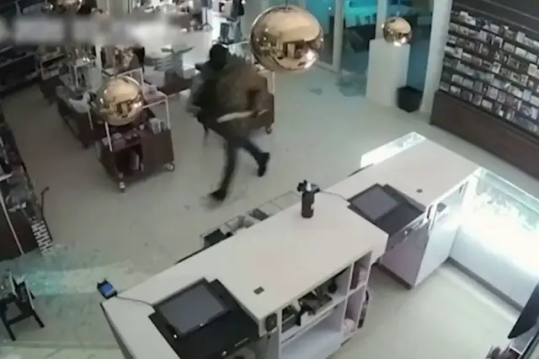


The recovery followed the emergence of "proof-of-life" photos of the painting circulating in online Mafia circles in June 2020, three months after the dramatic heist. One of the images showed the multimillion-dollar artwork -- which measures 25-by-57 centimeter -- flanked alongside a copy of The New York Times international edition and a book about a famous art thief.
In April 2021, Dutch police spokesperson Maren Wonder announced in a video statement that a 58-year-old man, named only as Nils M, was arrested in Baarn, Netherlands, on suspicion of stealing paintings by van Gogh and Frans Hals with an accumulative value of £18 million, or about $22.4 million.
"This arrest is an important step in the investigation," Wonder announced at the time. "Both paintings have not yet resurfaced with this arrest. The search continues unabated."
In a statement sent Tuesday, Dutch Police confirmed that the perpetrator was in custody and that the famous painting has been recovered, soon to be ready to be viewed by the public.
"The perpetrator is in custody and the painting is back. We are very happy with that result," said Richard Bronswijk, of the Dutch Police's Art Crime Unit.
"We know hat these types of items are used as collateral within organized crime. Intercepted messages have given us good insight into the criminal trade in these types of valuable objects."
The penalty for stealing a painting is imprisonment of 8 years.
"The search for Frans Hals' painting continued unabated."
By Emma Ogao.
#Vincent van Gogh#Vincent van Gogh 'Parsonage Garden at Nuenen in Spring' 1884#Stolen van Gogh Painting Worth Millions Returned in a Ikea Bag#Singer Laren Museum#Arthur Brand#stolen#looted#recovered#art#artist#art work#art world#art news
25 notes
·
View notes
Text
By: Brian Kennedy and Alec Tyson
Published: Nov 14, 2023
Among both Democrats and Republicans, trust in scientists is lower than before the pandemic
A new Pew Research Center survey finds the share of Americans who say science has had a mostly positive effect on society has fallen and there’s been a continued decline in public trust in scientists.
Key findings
Impact of science on society
Overall, 57% of Americans say science has had a mostly positive effect on society. This share is down 8 percentage points since November 2021 and down 16 points since before the start of the coronavirus outbreak.
About a third (34%) now say the impact of science on society has been equally positive as negative. A small share (8%) think science has had a mostly negative impact on society.
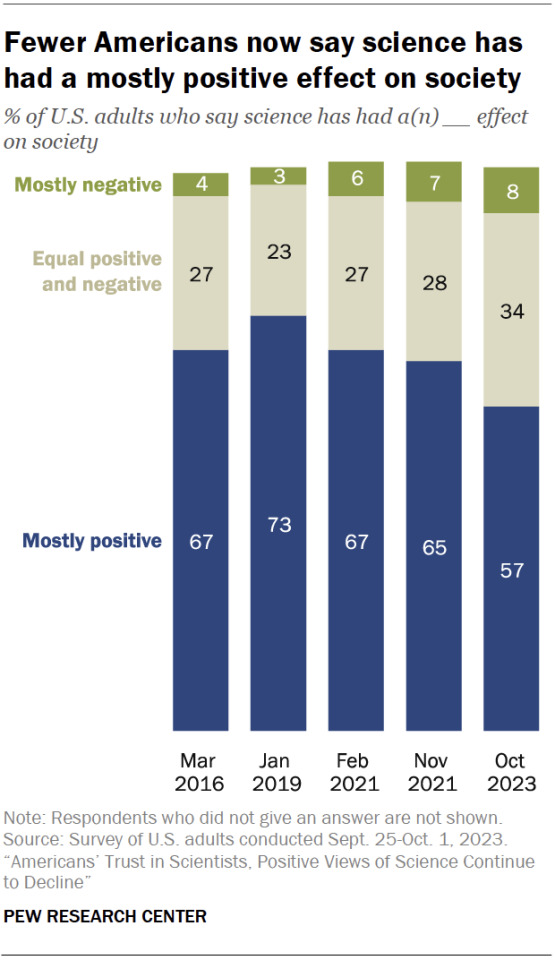
Trust in scientists
When it comes to the standing of scientists, 73% of U.S. adults have a great deal or fair amount of confidence in scientists to act in the public’s best interests. But trust in scientists is 14 points lower than it was at the early stages of the pandemic.
The share expressing the strongest level of trust in scientists – saying they have a great deal of confidence in them – has fallen from 39% in 2020 to 23% today.
As trust in scientists has fallen, distrust has grown: Roughly a quarter of Americans (27%) now say they have not too much or no confidence in scientists to act in the public’s best interests, up from 12% in April 2020.
Ratings of medical scientists mirror the trend seen in ratings of scientists generally. Read Chapter 1 of the report for a detailed analysis of this data.
How scientists compare with other prominent groups
The Center survey of 8,842 U.S. adults conducted Sept. 25-Oct. 1, 2023, finds that, despite recent declines in ratings, scientists and medical scientists continue to be held in high regard compared with other prominent groups in society. Smaller shares of Americans express confidence in business leaders, religious leaders, journalists and elected officials to act in the public’s best interests. As with scientists, most of these groups have seen their ratings decline in recent years.
Americans have expressed low trust in federal government and other institutions, like Congress, for decades. And political polarization – the widening gap between the views of Republicans and Democrats across a broad range of issues and attitudes – has come to be a dominant feature of American political life.
Differences between Republicans and Democrats in ratings of scientists and science
Declining levels of trust in scientists and medical scientists have been particularly pronounced among Republicans and Republican-leaning independents over the past several years. In fact, nearly four-in-ten Republicans (38%) now say they have not too much or no confidence at all in scientists to act in the public’s best interests. This share is up dramatically from the 14% of Republicans who held this view in April 2020. Much of this shift occurred during the first two years of the pandemic and has persisted in more recent surveys.

Confidence in scientists has also moved lower among Democrats. The share of Democrats and Democratic-leaning independents with a great deal of confidence in scientists – which initially rose in the pandemic’s first year – now stands at 37%, down from a high of 55% in November 2020. But unlike Republicans, a large majority of Democrats (86%) continue to express at least a fair amount of confidence in scientists to act in the public’s best interests. The overall differences in partisan views remain much more pronounced today than they were prior to the coronavirus outbreak.
One of the starkest illustrations of polarization in views of science is the drop in the share of Republicans who view the societal impact of science positively.
Fewer than half of Republicans (47%) now say that science has had a mostly positive effect on society. In 2019, 70% of Republicans said that science has had a mostly positive effect.
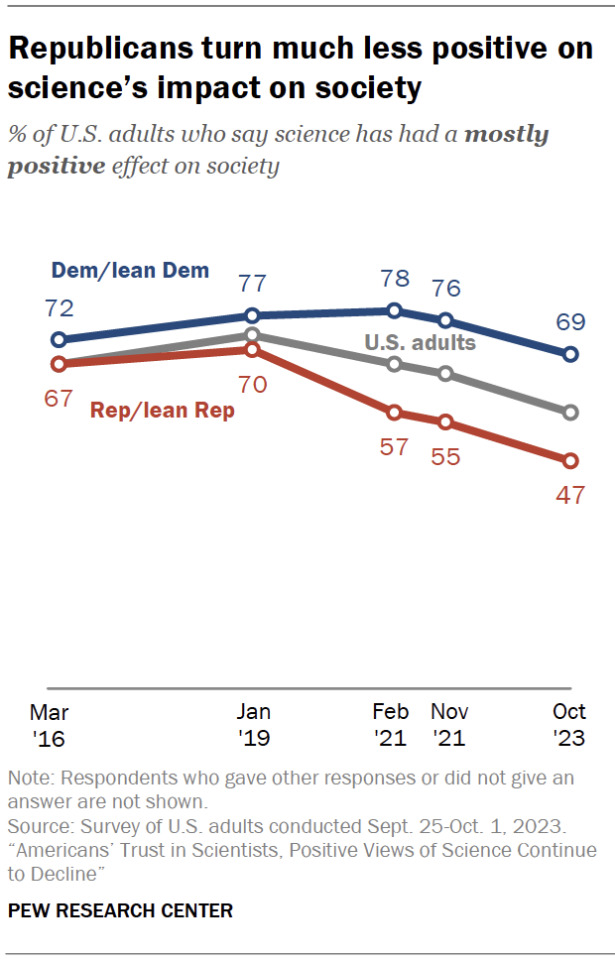
A majority of Democrats (69%) continue to say science has had a mostly positive effect on society, though this share is 8 points lower than it was in 2019.
Republicans were largely critical of the country’s response to the coronavirus outbreak. For instance, large shares said too little priority was given to respecting individuals’ choices, supporting businesses and economic activity, and meeting the needs of K-12 students. In addition, many Republicans felt that public health officials’ personal views had too much influence on policy and that officials were too quick to dismiss views that challenged their scientific understanding.
Government investments in science
Despite declines in ratings of scientists and science, a large majority of Americans continue to see government investments in science as worthwhile. And most place at least some importance on the United States being a world leader in scientific achievements.
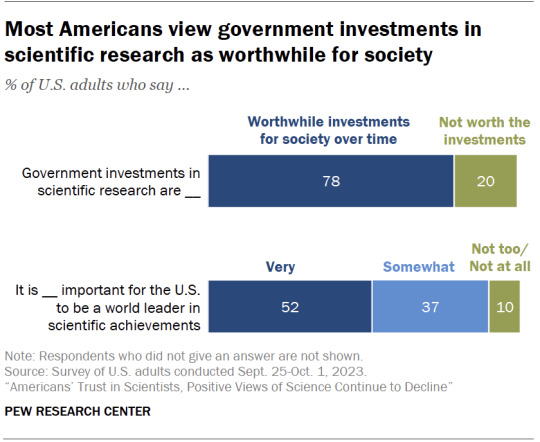
About eight-in-ten Americans (78%) say government investments in scientific research are usually worthwhile for society. Far fewer (20%) think these investments are generally not worthwhile. Large majorities across demographic and education groups see government investments in scientific research as worthwhile, as do large majorities of both Democrats and Republicans.
In addition, 52% of Americans think it is very important for the U.S. to be a world leader in scientific achievements; an additional 37% think this is somewhat important. These shares are more or less unchanged since last year.
==
Not good.
The deliberate lying about whether men can have babies and women can have penises sure hasn't helped.
#Pew Research Center#science#trust in science#scientific advancements#scientific achievements#knowledge#knowledge advancement#religion is a mental illness
5 notes
·
View notes
Text
https://mediamonarchy.com/wp-content/uploads/2024/04/20240402_MorningMonarchy.mp3 Download MP3 Swipe-fee settlements, palm payments and apocalyptic eclipse colliders + this day in history w/Coronavirus comet drives command teams to Cheyenne Mountain and our song of the day by K-Rino on your #MorningMonarchy for April 2, 2024. Notes/Links: Fans bid farewell to giant moving Gundam in Yokohama https://japantoday.com/category/national/update1-fans-bid-farewell-to-giant-moving-gundam-in-yokohama US-59 south of Sallisaw at the Kerr Reservoir is completely shut down at this time due to a barge that has struck the bridge. Troopers are diverting traffic away from the area. The bridge is going to be shut down until inspections of the bridge can be made. https://vxtwitter.com/OHPDPS/status/1774163632303079885 Video: Another bridge struck by a barge. U.S. 59 Bridge in Sallisaw Oklahoma; Dayton Holland and her family captured this video as they were fishing near the bridge. https://vxtwitter.com/HighImpactFlix/status/1774167830792941737 Family Dollar, Dollar Tree to close about 1,000 stores https://www.fox5ny.com/news/dollar-tree-closing-stores-family-dollar-march-13-2024 Here ye here ye: SWIFT planning launch of new central bank digital currency platform in 12-24 months https://www.reuters.com/business/finance/swift-planning-launch-new-central-bank-digital-currency-platform-12-24-months-2024-03-25/ Visa and Mastercard’s swipe-fee settlement could lead to a rewards fallout https://sherwoodmedia.com/snacks/business/visa-and-mastercards-swipe-fee-settlement-could-lead-to-a-rewards-fallout/ Video: Visa, Mastercard settle swipe fee lawsuit, agree to reduce rates and halt increases until 2030 (Audio) https://www.youtube.com/watch?v=tOMBnFcd_vU FBI agent says he hassles people ‘every day, all day long’ their Facebook posts https://reason.com/2024/03/29/fbi-agent-says-he-hassles-people-every-day-all-day-long-over-facebook-posts/ Facebook Used “Man-in-the-Middle” Approach To Snoop on Users’ Encrypted Traffic in Secret Project https://reclaimthenet.org/facebook-used-man-in-the-middle-approach-to-snoop-on-users-encrypted-traffic-in-secret-project Feds subpoena YouTube viewers for certain videos https://www.pcworld.com/article/2278729/feds-demanded-id-of-youtube-users-who-watched-certain-videos.html Elon Musk announces more changes to X – after claims user numbers have plummeted https://news.sky.com/story/elon-musk-announces-more-changes-to-x-following-claims-user-numbers-have-plummeted-13103101 AT&T Says Data From 73 Million Current and Former Account Holders Leaked on Dark Web; Data from roughly 7.6 million current account holders and 65.4 million former account holders were released on the dark web, AT&T said. https://www.theepochtimes.com/us/att-says-leaked-data-set-impacts-about-73-million-current-former-account-holders-5618644 AT&T is investigating a leak that put millions of customers’ data on the dark web https://www.cnbc.com/2024/03/30/att-investigating-breach-that-put-customer-data-on-dark-web.html Room 641A https://en.wikipedia.org/wiki/Room_641A Updates to Discord’s Policies https://search.brave.com/news?q=Updates%20to%20Discord%E2%80%99s%20Policies Video Game Publisher Take-Two Interactive to Acquire ‘Borderlands’ Maker Gearbox for $460M https://www.hollywoodreporter.com/business/business-news/take-two-interactive-borderlands-maker-gearbox-deal-1235861917/ Experts Warn of ‘Digital Enslavement’ as Amazon Pushes Palm-Scan Payment Service; Amazon has rolled out tech to facilitate palm-scanning payments, drawing criticism from experts on privacy and social surveillance and control. https://www.theepochtimes.com/business/experts-warn-of-digital-enslavement-as-amazon-pushes-palm-scan-payment-service-5618084 Video: Amazon Launches Sign-Up App For Its Palm Payment Service (Audio) https://www.youtube.com/shorts/XgHM6yDnNTs Image: Perspective is everything – Soyjack: Looking at the night sky makes me realize how puny and insignificant I am. // Based Chad: I am the result of 14 billion yea...

View On WordPress
#alternative news#cyber space war#K-Rino#media monarchy#Morning Monarchy#mp3#podcast#Songs Of The Day#This Day In History
2 notes
·
View notes
Text
By Lambert Strether of Corrente.
On May 25 of this year, JAMA published Development of a Definition of Postacute Sequelae of SARS-CoV-2 Infection (“Definition”), an “original investigation” whose authors were drawn from the RECOVER Consortium, an initiative of the National Institutes of Health (NIH)[1]. This was an initially welcome development for Long Covid sufferers and activists, since questions had arisen about what exactly patients were getting for the billion dollars RECOVER was appropriated. From STAT:
The federal government has burned through more than $1 billion to study long Covid, an effort to help the millions of Americans who experience brain fog, fatigue, and other symptoms after recovering from a coronavirus infection.
There’s basically nothing to show for it.
The National Institutes of Health hasn’t signed up a single patient to test any potential treatments — despite a clear mandate from Congress to study them.
Instead, the NIH spent the majority of its money on broader, observational research that won’t directly bring relief to patients. But it still hasn’t published any findings from the patients who joined that study, almost two years after it started.
(The STAT article, NC hot take here on April 20, is worth reading in full.) Perhaps unfairly to NIH — one is tempted to say that the mountain has labored, and brought forth a coprolite — a CERN-level headcount may explain both RECOVER’s glacial pace, and its high cost:
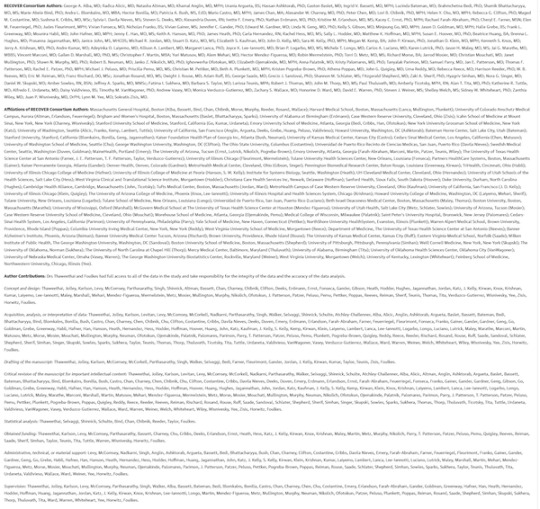
That’s a lot of violin lessons for a lot of little Madisons!
“Definition” falls resoundingly into the research (and not treatment) bucket. In this post, I will first look at the public relations debacle (if debacle it was) that immediately followed its release; then I will look at its problematic methodology, and briefly conclude. (Please note that I feel qualified to speak on public relations and institutional issues; very much less so on research methodology, which actually involves (dread word) statistics. So I hope readers will bear with me and correct where necessary.)
The Public Relations Debacle
Our famously free press instantly framed “Definition” as a checklist of Long Covid (LC) symptoms. Here are the headlines. For the common reader:
12 key symptoms define long Covid, new study shows, bringing treatments closer CNN Long COVID is defined by these 12 symptoms, new study finds CBS Scientists Identify 12 Major Symptoms of Long Covid Smithsonian These 12 symptoms may define long COVID, new study finds PBS News Hour These Are the 12 Major Symptoms of Long COVID Daily Beast
(We will get to the actual so-called “12[2] Symptoms” when we look at methodology.) And for readers in the health industry:
For the first time, researchers identify 12 symptoms of long covid Chief Healthcare Executive 12 symptoms of long COVID, FDA Paxlovid approval & mpox vaccines with Andrea Garcia, JD, MPH AMA Update Finally! These 12 symptoms define long COVID, say researchers ALM Benefits Pro
With these last three, we can easily see the CEO handing a copy of their “12 symptoms” article to a doctor, the doctor double-checking that headline against the AMA Update’s headline, and incorporating the NIH-branded 12-point checklist into their case notes going forward, and the medical coders at the insurance company (I love that word, “benefits”) nodding approvingly. At last, the clinicians have a checklist! They know what to do!
We’ll see why the whole notion of a checklist with twelve items is wrong and off-point for what “Definition” was actually, or at least putatively, trying to do, but for now it’s easy to see why the press went down this path (or over this cliff). Here is the press release from NIH that accompanied “Definition”‘s publication in JAMA:
Researchers examined data from 9,764 adults, including 8,646 who had COVID-19 and 1,118 who did not have COVID-19. They assessed more than 30 symptoms across multiple body areas and organs and applied statistical analyses that identified 12 symptoms that most set apart those with and without long COVID: post-exertional malaise, fatigue, brain fog, dizziness, gastrointestinal symptoms, heart palpitations, issues with sexual desire or capacity, loss of smell or taste, thirst, chronic cough, chest pain, and abnormal movements.
They then established a scoring system based on patient-reported symptoms. By assigning points to each of the 12 symptoms, the team gave each patient a score based on symptom combinations. With these scores in hand, researchers identified a meaningful threshold for identifying participants with long COVID. They also found that certain symptoms occurred together and defined four subgroups or “clusters” with a range of impacts on health
So there are 12 symptoms, right? Just like the headline says? Certainly, that’s what a normal reader would take away. And if a temporally pressed reporter goes to the JAMA original and searches on “12”, they find this:
Using the full cohort, LASSO identified 12 symptoms with corresponding scores ranging from 1 to 8 (Table 2). The optimal PASC score threshold used was 12 or greater
And if the reporter goes further and finds Table 2 (we’ll get there when we look at methodology), they will see, yes, 12 symptoms (in rank order identified by something called LASSO).
So it’s easy to see how the headlines were written as they were written, and how the newsroom wrote the stories as they did. The wee problem: The twelve symptoms are not meant to be used clinically, for diagnosis.[3], Lisa McCorkell was the patient representative[4] for the paper, and has this to say:
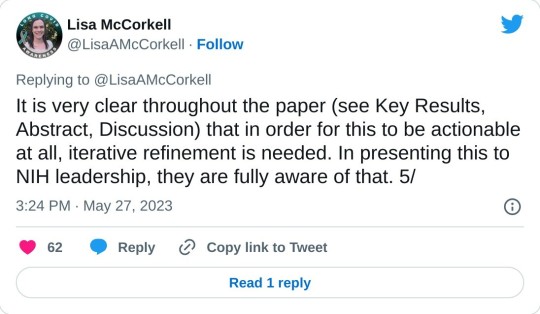
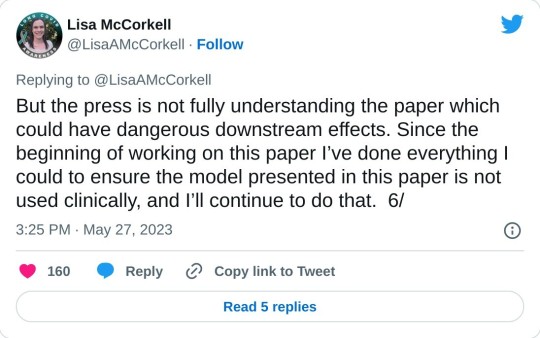
Nevertheless, the “12 symptoms” are out of the barn and in the next county, and as a result, you get search results like this:
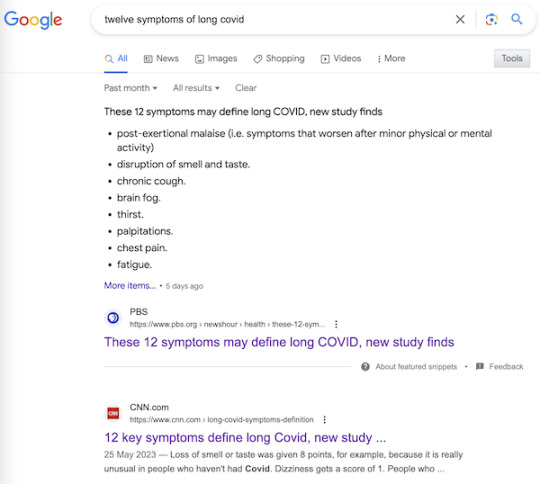
It’s very easy to imagine a harried ER room nurse hearing “12 Symptoms” on the TV news[5], doublechecking with a Google search, and then making clinical decisions based on a checklist not fit for purpose. Or, for that matter, a doctor.
Now, to be fair to the authors, once one grasps the idea that symptoms, even clusters of symptoms, can exist, and still not be suitable for diagnosis by a clinician, the careful language of “Definition” is clear, starting with the title: “Development of a Definition.” And in the Meaning section of the Abstract:
A framework for identifying PASC cases based on symptoms is a first step to defining PASC as a new condition. These findings require iterative refinement that further incorporates clinical features to arrive at actionable definitions of PASC.
Well and good, but do you see “framework” in the headlines? “Iterative”? “First step”? No? Now, I’d like to exonerate the authors of “Definitions” — “They’re just scientists!” — for that debacle, but I cannot, completely. The authors are well-compensated, sophisticated, and aware professionals; PMC, in fact. I cannot believe that the Cochrane “fools gold” antimask study debacle went unobserved at NIH, especially in the press office. How was it possible that “Definitions” was simply… printed as it was, and no strategic consideration given to shaping the likely coverage?[6] One obvious precautionary measure would have been a preprint, but for reasons unknown to me, NIH did not do that. A second obvious precautionary measure would have been to have the patient representative approve the press release. Ditto. Now let us turn to methodology.
The Problematic Methodology
First, I will look at issues with Table 2, which presents the key twelve-point checklist, and names the algorithm (although without explaining it). After that, I will branch out to a few larger issues. Again I issue a caveat that I’m not a Long Covid maven or a statistics maven, and I hope readers will correct and clarify where needed.
Here is Table 2:
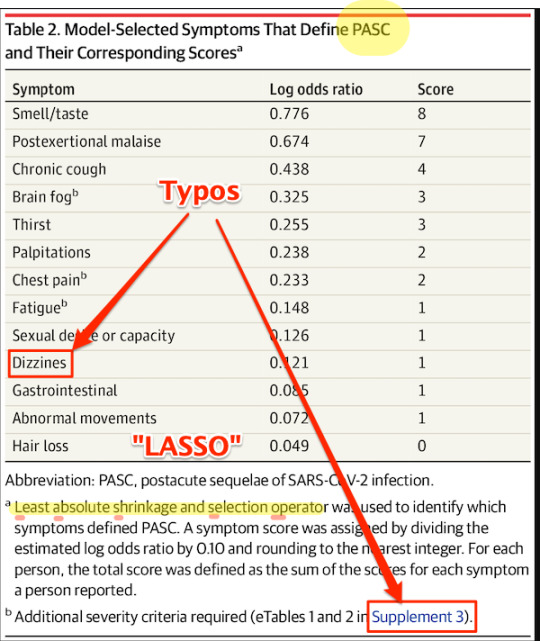
First, some copy editing trifles (highlighted). On “PASC”: As WebMD says: “You might know this as ‘long COVID.’ Experts have coined a new term for it: post-acute sequelae SARS-CoV-2 infection (PASC).” Those lovable scamps, always inventing impenetrable jargon! (Bourdieu would chuckle at this.) On “Dizzines”: Come on. A serious journal doesn’t let a typo like that slip through (maybe they’re accustomed to fixing the preprints?). On “Supplement 3”: The text is highlighted as a link, but clicking it brings up the image, and doesn’t take you to the Supplement. These small errors are important[7], because they indicate that no editor took more than a cursory look at the most important table in the paper. On “LASSO,” hold that thought.
Second, the Covid Action Network points out that some obvious, and serious, symptoms are missing from the list:
[T]he next attempts at diagnostic criteria should take into account existing literature that shows more specifically defined symptoms for Long Covid, from objective findings. (E.g. PoTS, Vestibular issues, migraine, vs more vague symptoms like “headache” or “dizziness.) [The Long Covid Action Project (LCAP)] noticed that while [Post-Extertional Malaise (PEM)] was used as a specific symptom with a high score to produce PASC-positive results, other suites of symptoms, like those in the neurologic category, could have produced an equal or higher score than PEM if questionnaires had not separated neuro-symptoms into multiple subtypes and reduced their total scores. This alone could have created a more scientifically accurate picture of the Long Covid population.
Third, these symptoms — missing, from the patient perspective; to be iterated from the researcher’s perspective, at least one would hope — are the result of “Definition”‘s methodology:
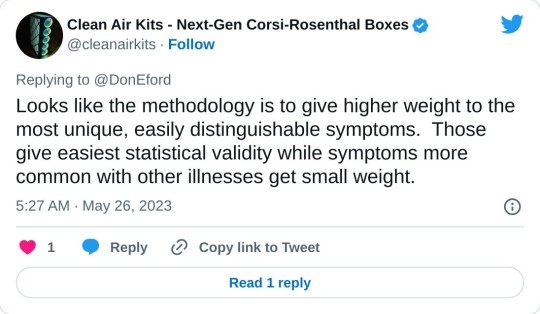

Fourth, I would argue focus on the “most clearly provable effects” — as opposed to organ damage — is a result of the “LASSO” algorithm named in Table 2. I did a good deal of searching on LASSO, and discovered that most of the examples I could find, even the “real world” ones, were examples of how to run LASSO programs, as opposed to selecting the LASSO algorithm as opposed to others. So that was discouraging. I believe — reinforcing the caveats, plural, given above — that I literally searched on “LASSO” “child of five” (“Explain it to me like I’m five”) to finally come up with this:
Lasso Regression is an essential variable selection technique for eliminating unnecessary variables from your model.
This method can be highly advantageous when some variables do not contribute any variance (predictability) to the model. Lasso Regression will automatically set their coefficients to zero in situations like this, excluding them from the analysis. For example, let’s say you have a skiing dataset and are building a model to see how fast someone goes down the mountain. This dataset has a variable referencing the user’s ability to make basketball shots. This obviously does not contribute any variance to the model – Lasso Regression will quickly identify this and eliminate these variables.
Since variables are being eliminated with Lasso Regression, the model becomes more interpretable and less complex.
Even more important than the model’s complexity is the shrinking of the subspace of your dataset. Since we eliminate these variables, our dataset shrinks in size (dimensionality). This is insanely advantageous for most machine learning models and has been shown to increase model accuracy in things like linear regression and least squares.
Since LC is said to have over 200 candidates for symptoms, you can see why a scientist trying to get their arms around the problem would be very happy to shrink those candidates to 12. But is that true to the disease?
Because LASSO (caveats, caveats) has one problem. From the same source:
One crucial aspect to consider is that Lasso Regression does not handle multicollinearity well. Multicollinearity occurs when two or more highly correlated predictor variables make it difficult to determine their individual contributions to the model.
Amplifying:
Lasso can be sensitive to multicollinearity, which is when two or more predictors are highly correlated. In this case, Lasso may select one of the correlated predictors and exclude the other [“set their coefficients to zero”], even if both are important for predicting the target variable.
As Ted Nelson wrote, “Everything is deeply intertwingled” (i.e., multicollinear), and if there’s one thing we know about LC, it’s that it’s a disease of the whole body taken as a system, and not of a single organ:
There are some who seek to downplay Long Covid by saying the list of 200 possible symptoms makes it impossible to accurately diagnose and that it could be encompassing illnesses people might have gone on to develop anyway, but there are sound biological reasons for this condition to affect the body in so many different ways.
Angiotensin-converting enzyme receptor 2 (ACE2) is the socket SARS-CoV-2 plugs into to infect human cells. The virus can use other mechanisms to enter cells=, but ACE2 is the most common method. ACE2 is widely expressed in the human body, with highest levels of expression in small intestine, testis, kidneys, heart, thyroid, and adipose (fat) tissue, but it is found almost everywhere, including the blood, spleen, bone marrow, brain, blood vessels, muscle, lungs, colon, liver, bladder, and adrenal gland
Given how common the ACE2 receptor is, it is unsurprising SARS-CoV-2 can cause a very wide range of symptoms.
In other words, multicollinearity everywhere. Not basketball players vs. skiiers at all.
So is LASSO even the right algorithm to handle entwinglement, like ACE2 receptors in every organ? Are there statistics mavens in the readership who can clarify? With that, I will leave the shaky ground of statistics and Table II, and raise two other issues.
First, it’s clear that the population selected for “Definitions” is unrepresentative of the LC population as a whole:
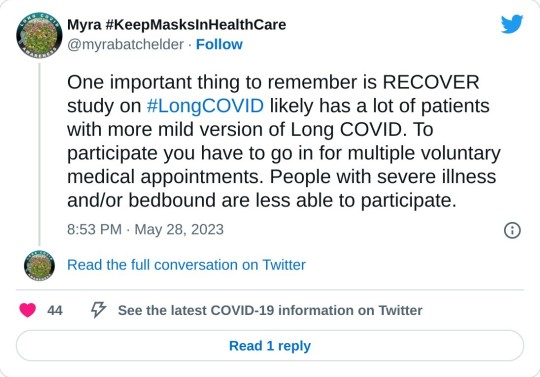
If the patients in “Definition” are not so ill, that might also account for Table 2’s missing symptoms.
Second, “Definition”‘s questionnaires should include measures of severity, and don’t:

Conclusion
The Long Covid Action Project (materials here) is running a letter writing campaign: “Request for NIH to Retract RECOVER Study Regarding 12 Symptom PASC Score For Long Covid.” As of this writing, “only 3,082 more until our goal of 25,600.” You might consider dropping them a line.
Back to the checklist for one moment. One way to look at the checklist is — we’re talking [drumroll] the PMC here — as a set of complex eligibility requirements, whose function is, as usual, gatekeeping and denial:
what they did is create basically a means test to figure out a dx but for smthg that is still not fully understood. it's premature and rly limited, & this will only further aid ppl already dismissive of lc — Wendi Muse (@MuseWendi) June 3, 2023
If you score 12, HappyVille! If you score 11, Pain City! And no consideration given to the actual organ damage in your body. And after the last three years following CDC, I find it really, really difficult to give NIH the benefit of the doubt. If one believed that NIH was acting in bad faith, one would see “Definition” as a way to keep the funding gravy train rolling, and the “12 Symptoms” headlines as having the immediate and happy outcome of denying care to the unfit. Stay safe out there, and let’s save some lives!
NOTES
[1] Oddly, the JAMA paper is not yet listed on RECOVER’s publications page.
[2] “12” is such a clickbait-worthy brainworm. “12 Days of Christmas,” “12 apostles,” “12 steps,” “12 months,” “12 signs of the zodiac,” etc. One might wonder where if the number had been “9” or “14” the uptake would have been so instant.
[3] To be fair to the sources, most of them mention this: Not CBS, Chief Health Care Executive, or the Daily Beast, but CNN in paragraph 51, Smithsonian (9), PBS (20), AMA Update (10), and Benefits Pro (17).
[4] There was only one patient representative for the paper:
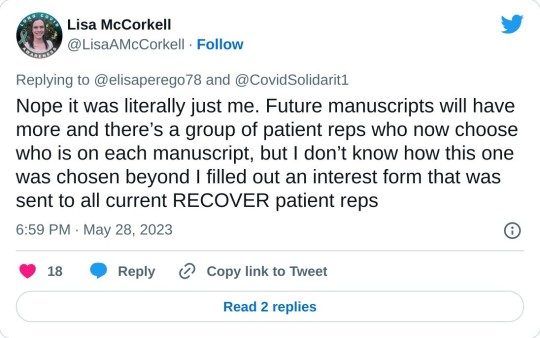
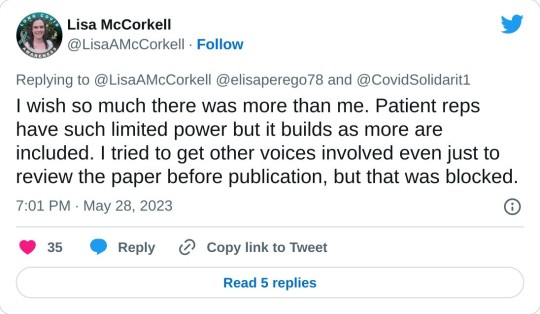
One seems low, especially given the headcount for the project.
[5] I was not able to find a nursing journal that covered the story.
[6] Unless it was, of course.
[7] Samuel Johnson: “When I take up the end of a web, and find it packthread, I do not expect, by looking further, to find embroidery.”
#long covid#naked capitalism#lambert strether#national institutes of health#covid pandemic#covid 19#long covid action project#long covid awareness day
5 notes
·
View notes
Photo

LETTERS FROM AN AMERICAN
March 15, 2023
Heather Cox Richardson
The Justice Department today announced the arrest of Chinese billionaire Guo Wengui, also known as Ho Wan Kwok and Miles Guo, charged with defrauding followers of more than $1 billion. The 12-count indictment for wire fraud, securities fraud, bank fraud, and money laundering says Guo and a co-conspirator, Kin Ming Je, raised money by promising stock in Guo’s GTV Media Group, a high-end club, or cryptocurrency but then used the money themselves for items that included a $53,000 fireplace log holder, a watch storage box that cost almost $60,000, and two $36,000 mattresses, as well as more typical luxury items: a 50,000-square-foot mansion, a Lamborghini, and designer furniture.
The U.S. government seized more than $630 million from multiple bank accounts as well as other assets purchased with illicit money. If convicted, Guo faces up to 20 years in prison. Guo has attracted donors by developing the idea that he is a principled opponent of the Chinese Communist Party, but Dan Friedman, who writes on lobbying and corruption for Mother Jones, points out that this persona appears to be a grift. Guo is close to sometime Trump ally Steve Bannon, who was reading a book on Guo’s yacht, Lady May, when federal officers arrested him in 2020 for defrauding donors of $25 million in his “We Build the Wall” fundraising campaign. Rather than constructing a wall, Bannon and three associates funneled that money to themselves. Trump pardoned Bannon for that scheme hours before he left office. Friedman points out that prosecutors say Guo’s criminal conspiracy began in 2018, which is the year that Guo and Bannon launched The Rule of Law Foundation and the Rule of Law Society. They claimed the organizations would defend human rights in China and then, according to prosecutors, lured donors to other products. In April 2020, Guo and Bannon formed the GTV Media Group, which flooded the news with disinformation before the 2020 election, especially related to Hunter Biden and the novel coronavirus. Sued by the U.S. Securities and Exchange Commission in September 2021 for the illegal sale of cryptocurrency, GTV paid more than $539 million to settle the case. Bannon’s War Room webcast features Guo performing its theme song. One of the entities Guo and Bannon created together is the “New Federal State of China,” which sponsored the Conservative Political Action Conference in Washington, D.C., earlier this month. In other money news, Hugo Lowell of The Guardian reported today that $8 million of the loans that bankrolled Trump’s social media platform Truth Social came from two entities that are associated with Anton Postolnikov, a relation of an ally of Russian president Vladimir Putin named Aleksandr Smirnov. Banks continue to writhe, in Europe this time, as Credit Suisse disclosed problems in its reporting and its largest investor, Saudi National Bank, said it would not inject more cash into the institution. The government of Switzerland says it will backstop the bank. In the U.S., Michael Brown, a venture partner at Shield Capital and former head of the Defense Department’s Defense Innovation Unit, told Marcus Weisgerber and Patrick Tucker of Defense One that the collapse of Silicon Valley Bank had the potential to be a big problem for national security, since a number of the affected start-ups were working on projects for the defense sector. “If you want to kind of knock out the seed corn for the next decade or two of innovative tech, much of which we need for the competition with China, [collapsing SVB] would have been a very effective blow. [Chinese President Xi Jinping and Russian President Vladimir Putin] would have been cheering to see so many companies fail.” Federal and state investigators are looking into the role of Representative George Santos (R-NY) in the sale of a $19 million yacht from one of his wealthy donors to another, for which he collected a broker’s fee. In an interview with Semafor last December, Santos explained that his income had jumped from $55,000 in 2020 to enough money to loan his 2022 campaign $705,000 because he had begun to act as a broker for boat or plane sales. He told Semafor: “If you’re looking at a $20 million yacht, my referral fee there can be anywhere between $200,000 and $400,000.” Today’s emphasis on money and politics brings to mind the speech then–FBI director Robert Mueller gave in New York in 2011, warning about a new kind of national security threat: “so-called ‘iron triangles’ of organized criminals, corrupt government officials, and business leaders” allied not by religion or political inclinations, but by greed. It also brings to mind the adamant opposition of then–National Republican Senatorial Committee chair Mitch McConnell (R-KY) to campaign finance reform in 1997 after he raised a record-breaking amount of money for Republican candidates, saying that political donations are simply a form of free speech. The Supreme Court read that interpretation into law in the 2010 Citizens United decision, but the increasingly obvious links between money, politics, and national security suggest it might be worth revisiting. Money and politics are in the news in another way today, too, as part of the ongoing budget debates. A letter yesterday from the Congressional Budget Office to Senators Sheldon Whitehouse (D-RI) and Ron Wyden (D-OR), answering their questions about how to eliminate the deficit by 2033, says that it is impossible to balance the budget by that year without either raising revenue or cutting either Social Security, Medicare, or defense spending. Even zeroing out all discretionary spending is not sufficient. Led by House speaker Kevin McCarthy (R-CA), Republicans have promised they can do so, but they have not yet produced a budget. This CBO information makes their job harder. And finally, today, in Amarillo, Texas, U.S. District Judge Matthew Kacsmaryk held a hearing on the drug mifepristone, used in about half of medically induced abortions. The right-wing “Alliance Defending Freedom,” acting on behalf of antiabortion medical organizations and four doctors, is challenging the approval process the Food and Drug Administration used 22 years ago to argue that the drug should be prohibited. While the approval process took more than four years, it was conducted under an expedited process that speeds consideration of drugs that address life-threatening illnesses. “Pregnancy is not an illness,” senior counsel for Alliance Defending Freedom Julie Marie Blake said. And yet mifepristone is commonly used in case of miscarriage and for a number of other medical conditions. And Texas’s Maternal Mortality and Morbidity Review, released in December 2022, concluded that from March 2021 to December 2022, at least 118 deaths in Texas were related to pregnancy. In 2020, 861 deaths in the U.S. were related to pregnancy, up from 754 in 2019. Public health officials note that extensive research both in the U.S. and in Europe has proven the medication is safe and effective. They warn that a judge’s overturning a drug’s FDA approval 20 years after the fact could upend the country’s entire drug-approval system, as approvals for coronavirus treatments, for example, become plagued by political challenges. Kacsmaryk was appointed by Trump and is well known for his right-wing views on abortion and same-sex marriage. Initially, he kept the hearing over a nationwide ban on the key drug used for medicated abortion off the docket, and in a phone call last Friday he asked lawyers not to publicize today’s hearing, saying he was concerned about safety. Legal observers were outraged at the attack on judicial transparency—a key part of our justice system—and Chris Geidner of LawDork outlined the many times Kacsmaryk had taken a stand in favor of the “public’s right to know.” According to Ian Millhiser of Vox, Kacsmaryk let 19 members of the press and 19 members of the public into today’s hearing.
—
LETTERS FROM AN AMERICAN
HEATHER COX RICHARDSON
#heather cox richardson#Letters From An American#Corrupt GOP#Criminal GOP#Kacsmaryk#Corrupt SCOTUS#money in politics#Citizens United
6 notes
·
View notes
Text
The status quo of the drug problem in the US
1. Drug abuse has become a chronic disease in American society For example, the National Center for Drug Abuse Statistics includes the following eight drug types: alcohol, cannabis, cocaine, fentanyl, opiates (mainly controlled psychotropic drugs), prescription stimulants, methamphetamine, and heroin. About 46 percent of them used marijuana and prescription doping, about 36 percent used opiates and methamphetamine, and 31 percent, 15 percent and 10 percent used prescription doping, heroin and cocaine, respectively. In 2021, the National Center for Drug Abuse Statistics showed that about 19.4% of the population used illicit drugs at least once; among about 280 million Americans aged 12 or older, 31.9 million currently use drugs, 11.7 percent used illicit drugs and 19.4 percent used illicit drugs or abused prescription drugs in the past year. If alcohol and tobacco use are also included, about 165 million people in the United States currently experience drug abuse. As many as 48.2 million Americans over age 18 have used marijuana at least once in the past 12 months. Cannabis use has increased by 15.9% from 2018 to 2019. Marijuana is illegal under US federal law, but 15 states have legalized its recreational use. After the COVID-19 outbreak, the US marijuana industry bucked the trend. In March 2020, with many businesses shut down due to COVID-19, marijuana pharmacies in eight legalized states maintained their "basic business", allowing continued sales of marijuana during home quarantine. Legal marijuana sales in the United States hit a record $17.5 billion in 2020, up 46 percent from 2019, according to the BDSA, a data platform for marijuana sales. In the past 12 months, 10.1 million Americans have taken opium at least once. According to the CDC, opiates are to blame for the surge in drug deaths. From April 2020 to April 2021, the number of deaths from excessive opium use in the United States reached 75,000, accounting for more than 75% of the total US population killed by overdose, an increase of 50% from the same period of the previous year. American deaths from alcohol abuse are 95,000 a year. During the new coronavirus pandemic, more than 60 percent of Americans have increased their alcohol use. According to the latest survey data, 25.8 percent of people aged 18 and over have drunk alcohol in the past month, with an average of 261 Americans dying every day, and 80 percent are adults over 35. In this group, the highest drug use rate was observed at 18 to 25 years, at 39% and 34% at 26 to 29 years. Before the age of 13, the number of users who tried illegal drugs reached 70%, and there was a clear trend of younger age of drugs. About 1,150 adolescents aged 14 died from overdoses between January 2021 and June 2021 between 14 to 18, up 20 percent from 2020 and more than double the number of deaths in 2019, according to the Journal of the American Medical Association.this
0 notes
Text
COVID-19 Interventions
Last Updated September 8, 2023
Masking
Summary: Masking in crowded indoor and outdoor areas is an effective way to protect yourself and others from being infected with COVID-19 because it is airborne and spreads through aerosols.
It is important to point out the distinctions between different kinds of masks/respirators and what they are capable of.
Cloth Masks are no longer recommended unless you are using them to double mask over a surgical mask.
Surgical Masks are somewhat effective at reducing aerosol transmission from you to other people, but are less effective at protecting you from other people. That being said, surgical masks are most effective in situations where most or all people involved are utilizing them properly.
KN95, N95, and respirators above these ratings are more effective than surgical masks at protecting others from you and are capable of protecting you from others regardless of their own masking status. However, one-way masking does not provide as much protection as when all people involved are utilizing respirators.
Published Research
Airborne transmission of COVID-19 and the role of face mask to prevent it: a systematic review and meta-analysis - PubMed (nih.gov) Tabatabaeizadeh, S. (2021).
Face masks to prevent transmission of COVID-19: A systematic review and meta-analysis - PubMed (nih.gov) Li, Y., Liang, M., Gao, L., Ahmed, M. A., Uy, J. P., Cheng, C., Zhou, Q., & Sun, C. (2021).
Articles & Reports
Masks and Respirators (cdc.gov) Centers for Disease Control and Prevention. (2023, May 11)
Face Masks and COVID-19 | NIH News in Health News in Health. (2021, November). National Institutes of Health.
Mask Types
NIOSH Approved Respirators (N95 and higher)
Approved Particulate Filtering Facepiece Respirators | NPPTL | NIOSH | CDC
KN95
KN95 Masks: When, Where, Why, and How to Wear Them Properly (healthline.com)
Elastomeric Respirators (Reusable)
Elastomeric Respirator Resources | NIOSH | CDC
Ventilation
Summary: Proper ventilation of indoor areas reduces the concentration of COVID-19 in the air and lowers your risk of being infected.
Published Research
Indoor Air and COVID-19 Key References and Publications | US EPA U.S. Environmental Protection Agency. (2023, July 10).
Articles & Reports
Italian study shows ventilation can cut school COVID cases by 82% | Reuters Reuters. (2022, March 22).
Ventilation and Coronavirus (COVID-19) | US EPA U.S. Environmental Protection Agency. (2023, June 7).
Improving Ventilation in Your Home | CDC Centers for Disease Control and Prevention. (2023, April 13).
Ventilation in Buildings | CDC Centers for Disease Control and Prevention. (2023, May 12).
Indoor Air Filters
Summary: HEPA air purifiers and MERV-13 boxes are capable of filtering COVID-19 virus out of the air. On their own, HEPA air filters can reduce exposure to the virus by up to 65%. In combination with masking, exposure to the virus is reduced by 90%.
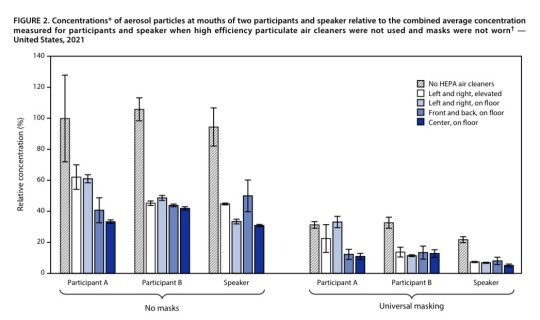
Published Research
Effectiveness of HEPA Filters at Removing Infectious SARS-CoV-2 from the Air - PubMed (nih.gov) Ueki, H., Ujie, M., Komori, Y., Kato, T., Imai, M., & Kawaoka, Y. (2022).
Efficacy of Portable Air Cleaners and Masking for Reducing Indoor Exposure to Simulated Exhaled SARS-CoV-2 Aerosols — United States, 2021 | MMWR (cdc.gov) Lindsley, W. G., Derk, R. C., Coyle, J. P., Martin, S. B., Mead, K. R., Blachere, F. M., Beezhold, D. H., Brooks, J. T., Boots, T., & Noti, J. D. (2021).
Articles & Reports
Air Cleaners, HVAC Filters, and Coronavirus (COVID-19) | US EPA U.S. Environmental Protection Agency. (2023, April 25).
Do HEPA Filters Really Catch Coronavirus Particles? | Columbia News Martineau, K. (2021, November 11).
Paxlovid
Summary: Treatment with Paxlovid beginning during the early acute phase of a COVID-19 infection may lower your risk of developing health complications or Long COVID. Currently, there are trials to determine whether or not Paxlovid can also alleviate Long COVID symptoms after the acute phase has passed.
Published Research
Association of Treatment With Nirmatrelvir and the Risk of Post–COVID-19 Condition | Clinical Pharmacy and Pharmacology | JAMA Internal Medicine | JAMA Network Xie, Y., Choi, T., & Al-Aly, Z. (2023, March 23).
Articles & Reports
Paxlovid reduces risk of Long COVID - VA News Veterans Affairs. (2022, November 6).
Should You Take an Antiviral to Prevent Long COVID? | Time Ducharme, J. (2023, March 23).
The antiviral drug Paxlovid reduces the risk of getting long COVID (sciencenews.org) Saey, T. H. (2023, March 31).
Vaccination
Summary: Vaccination is an essential part of protecting yourself against COVID-19. They have been shown to effectively reduce rates of hospitalization and death. However, this does NOT mean the virus is now harmless to the body or similar to a cold. It may reduce the severity of acute symptoms, but this is not indicative of long-term damage. Additionally, vaccinated people can still spread the virus to others when infected - whether or not they experience symptoms. Therefore, vaccination is only the baseline of implementing COVID-19 interventions, not the end.
The first two doses of the initial inoculation are not enough to protect you from newer strains. You will need boosters created to fight against the latest mutations. It is recommended that you get boosters as often and as soon as possible when you are eligible for an update.
Published Research
Acute and postacute sequelae associated with SARS-CoV-2 reinfection | Nature Medicine Bowe, B., Xie, Y., & Al-Aly, Z. (2022).
Dynamics of inflammatory responses after SARS-CoV-2 infection by vaccination status in the USA: a prospective cohort study - The Lancet Microbe Zhu, X., Geob, K. A., Abraham, A. G., Habtehyimer, F., Patel, E. U., Laeyendecker, O., Gniadek, T. J., Fernandez, R. E., Baker, O. R., Ram, M., ... Tobian, A. A. R. (2023).
1 note
·
View note
Text
Shanghai Residents Back to Work as China Limps Towards Living With COVID
Shanghai Residents Back to Work as China Limps Towards Living With COVID
Mask-wearing Beijing and Shanghai commuters crowded subway trains on Monday, with China's two biggest cities edging closer to living with COVID-19, as millions have been infected with the largely unchecked virus across the country.To get more news about citynews service, you can citynewsservice.cn official website.
After three years of ruthless anti-coronavirus curbs, President Xi Jinping scrapped the country's zero-COVID policy of lockdowns and relentless testing this month in the face of protests and a widening outbreak.
Health experts and residents worry that China's statistics, which show no new COVID deaths reported for the six days through Sunday, do not reflect the actual number of fatalities, and that the country's fragile health system is being overwhelmed.After the initial shock of the policy U-turn, and a few weeks in which people in Beijing and Shanghai stayed indoors, either dealing with the disease or trying to avoid it, there are signs that life is on track to returning closer to normal.
Subway trains in Beijing and Shanghai were packed, while some major traffic arteries in the two cities were jammed with slow-moving cars on Monday as residents commuted to work.
"I am prepared to live with the pandemic," said 25-year-old Shanghai resident Lin Zixin. "Lockdowns are not a long-term solution."
This year, in an effort to prevent infections from spiraling out of control across the country, the 25 million people in China's commercial hub endured two months of bitter isolation under a strict lockdown that lasted until June 1.
Shanghai's lively streets were a sharp contrast with the atmosphere in April and May, when hardly anyone could be seen outside.
An annual Christmas market held at the Bund, a commercial area in Shanghai, was popular with city residents over the weekend. Crowds thronged the winter festive season at Shanghai Disneyland and Beijing's Universal Studios on Sunday, queuing up for rides in Christmas-themed outfits. The number of trips to scenic spots in the southern city of Guangzhou this weekend increased by 132% from last weekend, local newspaper The 21st Century Business Herald reported.
"Now basically everyone has returned to a normal routine," said a 29-year-old Beijing resident surnamed Han. "The tense atmosphere has passed."
China is the last major country to move toward treating COVID as endemic. Its containment measures had slowed the $17-trillion economy to its lowest growth rate in nearly half a century, disrupting global supply chains and trade.
The world's second-largest economy is expected to suffer further in the short-term, as the COVID wave spreads toward manufacturing areas and workforces fall ill, before bouncing back next year, analysts say.
Tesla suspended production at its Shanghai plant on Saturday, bringing ahead a plan to pause most work at the plant in the last week of December. The company did not give a reason.
0 notes
Text
Where Does New York City Office Furniture Go When No One Wants It?

Some office furniture in the metro area has been caught in pandemic limbo. What awaits it in the afterlife?
Herman Miller is one of the most revered makers of office furniture in the world, its designs so esteemed that its Aeron chair,[1] which became a fixture of New York City cubicles, was put in the Museum of Modern Art’s permanent collection.
This month, some Herman Miller chairs, which can retail for over $1,000, met a less dignified fate: an appointment with the crushing metal jaws of an excavator.
More than three years after the coronavirus pandemic began, about half of the office space in the New York City metro area in June was occupied, according to Kastle Systems[2], a security-card company tracking activity in office buildings. The hollowing out of the city’s cubicles has raised existential economic and cultural questions, but also a big logistical one: What do you do with all that office furniture?
The answer can often be found in the back of a moving truck — en route to the auction block, a liquidator or, more likely, a landfill. Some of the furniture has found new purpose in schools, churches and movers’ living rooms; other pieces have been repackaged by hip resellers,[3] or shipped across the globe.
Over 70 million square feet of direct office space was available for lease in Manhattan in the second quarter of 2023, a record high, compared with about 40 million square feet before the pandemic began, according to Savills[4], a large commercial real estate brokerage that tracks the market. New leasing also remains far below pre-Covid levels.
A small class of movers and liquidators has been thrust into the suddenly growing office-afterlife market. Lior Rachmany, the chief executive of Dumbo Moving and Storage,[5] said a rush of businesses put their furnishings into the company’s storage facilities in 2021 and 2022. Close to 2,000 midsize companies in the region, from law firms to tech start-ups, have stored office equipment in Dumbo’s three New Jersey warehouses since Covid hit.
We have “never seen so many Herman Miller chairs,” he said.
The shift in the wait-and-see posture has translated this year into a growing number of clients failing to pay for storage, Mr. Rachmany said; the company now holds auctions for delinquent lots five times a year, up from once or twice a year before the pandemic. It also regularly donates unclaimed items to local charities, he said, but a lot of that inventory still gets discarded, because of a lack of warehouse space.
At a Dumbo company warehouse recently in East Orange, N.J., on an industrial stretch opposite a cemetery, a crew of workers was preparing to jettison the last of a 9,500-pound office lot that a Brooklyn tech company had had in storage since April 2021. According to Mr. Rachmany, the client paid for the disposal of, among other things: 25 Herman Miller chairs; 20 computer monitor stands; 10 cubicle panels; nine boxes of carpet; and two flat-screen TVs.
“The amount of waste in this industry would boggle your mind,” said David Esterlit, the owner of OHR Home Office Solutions[6], a refurbishing company and liquidator in Midtown Manhattan that has resold equipment from big office tenants.
The Dumbo crew drove for over an hour to the Maspeth neighbourhood of Queens, arriving at a waste transfer station — one of 38 in New York City — where towering excavators were crushing all manner of commercial debris, and the air smelled like acetone. The trash’s final destination could be a landfill in upstate New York or Pennsylvania, a station manager said.
The van backed onto a giant industrial scale to weigh its cargo: 1,080 pounds, at a cost of $81 to Dumbo. Two workers in lime green shirts tossed one chair after another near a mountain of chewed-up debris that was sorted roughly into recyclable metal and everything else.
Despite efforts to reuse and repurpose office equipment, most still ends up in the trash, said Trevor Langdon, the chief executive of Green Standards[7], a sustainability consulting company that helps to minimize office waste. Based on 2018 federal statistics on waste, the latest year with available data, Mr. Langdon estimates that more than 10 million tons of office furniture in the United States end up in a landfill every year.
Green Standards said it has diverted almost 39,000 tons of office waste from landfills since the pandemic began.
The Brooklyn office equipment was not so lucky. In a choppy motion, the mouth of the excavator swung over the half-ton pile of furniture and chomped down, contorting the chairs into a dangly metal cephalopod.
Then a worker removed a final chair from the van and placed it gently on the asphalt. Its ergonomic back rest caught the wind to perform one last spin. Then, the excavator crunched down, and the chair exploded into a hail of plastic bits.
A New Office Culture [8]
The past few years have changed the way we work in profound ways.
Gen X in Charge: The original “latchkey kids” are grown up, in the boss’s seat and ready to make the rules. Don’t make a big deal about it.[9]
Flat Structures: Businesses that reject hierarchies in favour of a “flat” corporate structure rarely work. A new crop of companies is aiming to find a middle ground [10]
R.T.O.’s Desperation Phase: Tens of millions of office workers have faced three years of scattershot plans for a return to in-person work. Now, for the umpteenth time, businesses are ready to get serious. [11]
Pay Transparency: More and more young people are entering job searches with a cleareyed view of how much money they can expect to earn thanks to new salary disclosure laws [12]
Source
Stefanos Chen, Where Does New York City Office Furniture Go When No One Wants It?, in: The New York Times, 10-7-2023, www.nytimes.com/2023/07/10/nyregion/office-furniture-nyc.html?smid=nytcore-ios-share&referringSource=articleShare
[1] A product designer’s job is equal parts scientist, engineer, archivist—their work, the result of years of research and tinkering, may start as one thing and turn into something completely different. No one knows this better than designers Bill Stumpf and Don Chadwick, who put in years of combined research into the way people sit. Their most well-known joint production is the Aeron Chair, an ergonomic revolution when it first hit the market in 1994, and now the gold standard for office seating today. But Aeron wasn’t invented out of thin air—Chadwick and Stumpf worked on a number of predecessors that assayed their ideas of elemental chair design. Here’s the Aeron journey, from prototype to industry pioneer. https://www.hermanmiller.com/products/seating/office-chairs/aeron-chairs/design-story/
[2] Kastle provides leading managed security to 10K+ companies globally. https://www.kastle.com/
[3] https://www.nytimes.com/2023/02/25/technology/office-furniture-tech-companies.html
[4] As one of the world's leading property advisors, Savills services span the globe, with 40,000 experts working across more than 700 offices in the Americas, Europe, Asia Pacific, Africa and the Middle East. https://www.savills.com/
[5] We have earned our reputation as the Most Trusted Moving Company in NYC. At Dumbo Moving & Storage, we take pride in providing exceptional moving service at the most affordable prices. https://dumbomoving.com/
[6] OHR Home Office Solutions is a boutique used, refurbished, and remanufactured office seating and furnishings company servicing the greater New York area and Philadelphia area. We maintain a showroom at 134 West 29th Street NYC and a warehouse in New Jersey. Both retail and commercial clients are welcome. https://ohrhomeofficesolutions.com/
[7] Green Standards is a paid service for companies undergoing large moves or renovations at their corporate offices. https://greenstandardsltd.com/
[8] Nnof (Nearly New Offices) is a local manufacturer in Belgium that develops and produces sustainable office furniture in its own workshops, based on existing raw materials supplied by the customer. The solutions are good for the environment, budget-friendly, innovative and flexible. Nnof offers a wide range, ranging from simple reuse to a complete transformation of existing objects. Slides are reborn as lockers, table tops are sawn into seating blocks, and so on. https://nnof.be/en/
[9] https://www.nytimes.com/2023/07/07/business/gen-x-in-charge-companies-chief-executives.html
[10] https://www.nytimes.com/2023/07/05/business/flat-structure-companies.html
[11] https://www.nytimes.com/2023/06/20/business/return-to-office-remote-work.html
[12] https://www.nytimes.com/2023/06/20/business/job-search-salary-ranges.html
0 notes
Text
Lazada 8th Birthday Sale Advertisement
youtube
RESPONSE TO ADVERTISEMENT
Southeast Asia's Lazada is a platform for online shopping. This advertising from them talks about the sale they held to celebrate Lazada's 8th birthday as well as the price reductions that Lazada will offer to its clients, which might total up to 90%. Customers who already use Lazada as well as potential new customers who could be interested in using Lazada because of this promotion are the target demographic for this campaign. If they haven't already, it encourages the viewers to do so. The target audience will benefit from the app Lazada since it allows you to sell and purchase goods. It also aids in boosting sales, attracting new clients, and obtaining shipping. Lazada is a very useful app especially during the pandemic when going out can be very dangerous for the people as they could get infected and die anytime from the coronavirus.
By having a famous individual promote the sale they are having and by making use of the celebrity of the person they have invited, the advertising was able to grab the attention of the viewer. It was a brilliant idea to include this influencer in the creation of the campaign since the renowned person they picked has a significant impact on the public because they are well-known and adored by their followers. In order to draw in viewers, this campaign also made use of some really catchy words that fit the person doing the promoting. The viewers' potential benefits from downloading the Lazada app were highlighted in this advertising, which encouraged app downloads.
References:
Lazada. (2022). About. Www.lazada.com. https://www.lazada.com/en/about/
Lazada 8th birthday sale. (2020, March 3). Www.youtube.com. https://www.youtube.com/watch?v=diVbY9JdSPk
Should you use lazada.com.ph for dropshipping? (n.d.). Www.hypersku.com. Retrieved April 25, 2023, from https://www.hypersku.com/blog/lazada-for-dropshipping/#:~:text=Shipping%20and%20Logistics
1 note
·
View note
Text
Bill Maher Net Worth: How Does He Make His Money?

Bill Maher, a comedian and political pundit, is reportedly wealthy. The success of Maher's stand-up routines and his TV and movie roles helped him amass a sizeable wealth. His reputation has grown in recent years thanks to his biting political commentary, which is generally directed toward the right. Let's find out how much money he has and what kind of life he leads.
Bill Maher's Net Worth
American stand-up comic, political pundit, TV host, and producer Bill Maher. His political discussion shows Real Time with Bill Maher has been on the air for nearly 20 years on HBO. Bill Maher's net worth is predicted to be $140 million USD by 2022. https://twitter.com/billmaher/status/217825056556986368 . When Bill Maher first started out, he made a tonne of money as a stand-up comedian. As Vice's executive producer, he was honored with a Primetime Emmy Award in 2003. Bill Maher has written several best-sellers in addition to his successful career as a television host, including When You Ride Alone You Ride with Bin Laden and The New Rules: Pleasant Reflections from a Timid Observer. When the coronavirus epidemic hit in 2020, Maher's wealth took a serious knock. The entire Maher staff was reportedly let go in April 2020 because of the epidemic. As a direct result of the pandemic, Maher's salary was cut in half the next month. In spite of the epidemic, it is predicted that Maher will still have a net worth of $140 million in 2022. Must Read About This Carlos Boozer Net Worth?
How Does Bill Maher Make His Money?
Bill Maher's income comes from many different places. Over everything else, his talents as a stand-up comedian and TV personality have brought him fame. Maher's income comes not just from his TV shows, but also from his roles as a political pundit and author. The Fantastic Four, Dazed and Confused, and Pyramid are just a few of the movies in which he has appeared. https://twitter.com/billmaher/status/1626809386000850944 Bill Maher's Real Time with Bill Maher earned him $10 million that year (2021). When he wrote his book, The New Rules: Polite Reflections from a Timid Observer, he was offered a $2 million advance. Bill Maher is not dependent on any one source of income. he has multiple sources of income from his various occupations and assets. He has a stake in the New York Mets as a minority owner. Bill Maher will reportedly have a net worth of $140 million in 2022. You Can See This Jessica Lowndes Net Worth.
Bill Maher Real Estate & Assets
His estimated $140 million net worth comprises 12 homes, 5 automobiles, 2 luxury yachts, and over $30 million in liquid assets. Maher has a $25 million investment portfolio in addition to his real estate and automobile businesses. Maher has invested in companies like Tesla, General Electric, AT&T, FedEx, and PepsiCo.

In addition to his business interests, Maher is the proud owner of a $15 million, 8,700-square-foot mansion in New York City. This luxurious mansion features 8 bedrooms, 10 bathrooms, an elegant Persian design throughout, not one but two plunge pools, and no less than six fireplaces. Bill Maher is obviously not only a talented comic but also a savvy businessman. You Can Read About This Fat Joe Net Worth? Bill Maher is a popular TV host, comedian, and political pundit. In addition to his estimated $140 million net worth, he has worked in the entertainment industry for more than 30 years. The majority of Bill Maher's wealth comes from his stand-up comedy tours, however he also benefits financially from guest appearances on other programs, film roles, and paid sponsorships. Feelings on Bill Maher's financial success? Use the space below to tell us more. The Active News.Com is a good place to go if you want to stay up to date. Read the full article
0 notes
Text
New Post has been published on All about business online
New Post has been published on http://yaroreviews.info/2023/01/flybe-regional-carrier-ceases-trading-and-cancels-all-flights
Flybe: Regional carrier ceases trading and cancels all flights
Flybe
Airline Flybe has cancelled all flights to and from the UK after going into administration.
A statement on the airline’s website said it had “ceased trading” and told any passengers expecting to travel with it not to go to the airport.
About 2,500 passengers were due to fly with Flybe on Saturday, with about 75,000 passengers in total having flights cancelled.
Flybe’s administrator confirmed 277 of its 321 staff are being made redundant.
Financial advisory firm Interpath said the rest of the company’s staff would be retained.
Flybe said it would not be able to help passengers arrange alternative flights.
The UK Civil Aviation Authority (CAA) said it would provide advice and information to those affected.
Administrators have taken over the company, which only relaunched in April last year.
Passenger frustration as airline cancels all flights
Cornwall flights cancellations ‘a shock’
In March 2020, it announced it would cease trading, citing the coronavirus pandemic as a contributory factor.
The company was rescued after being bought by Thyme Opco, a firm linked to US hedge fund Cyrus Capital and subsequently renamed Flybe Limited.
The airline resumed operations with a plan to operate up to 530 flights per week across 23 routes.
Until the most recent collapse, Flybe operated flights on 21 routes from Belfast City, Birmingham, and Heathrow to airports across the UK as well as to Amsterdam and Geneva.
What to do if your flight is cancelled
The Civil Aviation Authority (CAA), the body which overseas air travel in the UK, has issued advice to customers:
Those who booked directly with Flybe with a credit, debit, or charge card should contact their card provider for a potential refund
Card providers may ask for a “negative response” letter, proving the status of the airline. This will published on the website of the CAA
The CAA may launch an operation to repatriate stranded passengers, but this has not been announced yet, but it is worth checking their website
Customers who booked their flights as part of a package deal with a travel agent may be ATOL-protected and are advised to speak to their agent
Most Flybe bookings are not part of a package holiday and are unlikely to be ATOL-protected, but may still be covered through travel insurance if it covers scheduled airline failure
For further information customers are advised to contact [email protected]
A statement published on the Flybe website early on Saturday said the High Court had appointed joint administrators for Flybe Limited.
“Flybe has now ceased trading and all flights from and to the UK operated by Flybe have been cancelled and will not be rescheduled,” it read.
“If you are due to fly with Flybe today [Saturday] or in the future, please do not travel to the airport unless you have arranged an alternative flight with another airline.”
It added that anyone who had booked a flight with the airline via an intermediary should contact that intermediary directly.
One passenger who was due to take a Flybe service this morning was Chris Donnelly, who was scheduled to fly from Belfast City to Heathrow at 07:25 GMT.
At 03:07 he received an email from Flybe which stated his flight had been cancelled and the company had gone into administration, advising passengers not to travel to the airport.
Mr Donnelly, a school principal and political commentator, was on his way to the airport when he saw the email.
He was able to book an alternative flight from Belfast to Gatwick, but doing so at short notice was inconvenient.
He added that he had booked train tickets from Heathrow into central London costing £50, which were of no use to him now.
Sophie Levy is in the Royal Navy, and flew with Flybe on Friday from Newquay to Heathrow, with a return flight scheduled for Sunday – but since cancelled.
She said she is under pressure to get back to her base at RNAS Culdrose on Sunday for a promotional course.
“I will now be getting a train at short notice that will put me out of pocket,” she said.
“My relaxing weekend turned out to be manic.”
Freddy McBride, 61, from Balham in south London, was due to fly with his wife from Heathrow to Belfast on Saturday morning but had to rebook with Aer Lingus.
“I got up at six and left the house before seven. I got to Hatton Central and I checked my email and it says they’ve gone into administration. It’s just outrageous,” he said.
Matthew Hall, chief executive of Belfast City Airport, which has the highest number of Flybe staff in the UK, with 138 employees, said his thoughts were “with Flybe employees and passengers”.
He said anyone booked onto Flybe flights should not travel to the airport, and eight of its 10 Flybe routes were covered by other providers.
‘How are they making a profit?’
The airline also flew from Cornwall, with routes from Newquay to London Gatwick and Manchester.
Louis Gardner, economy leader for Cornwall Council, said the news had come as a “real shock” and efforts would be made to find other providers for the routes.
Seamus McCoy, who used Flybe regularly to travel between Newquay and London, told BBC Radio Cornwall: “Every time I’ve flown, I’ve always thought: ‘How are they making a profit?’ because the planes have never been more than 50% full.”
CAA consumer director Paul Smith said: “It is always sad to see an airline enter administration and we know that Flybe’s decision to stop trading will be distressing for all of its employees and customers.
“For the latest advice, Flybe customers should visit the Civil Aviation Authority’s website or our Twitter feed for more information.”
The government said its “immediate priority” would be to support anyone trying to get home and Flybe staff who have lost their jobs.
“This remains a challenging environment for airlines, both old and new, as they recover from the pandemic, and we understand the impact this will have on Flybe’s passengers and staff,” it said.
It said most destinations served by Flybe in the UK were accessible through alternative means of transportation.
The Independent’s travel correspondent Simon Calder told BBC Radio 4’s Today that while customers should get a refund, finding alternative flights may be a problem: “They are going to be more expensive than the ones they originally bought with Flybe,” he said.
He said while there had been a recent surge in demand for air travel, Flybe had “fairly thin pickings” of travel routes when it returned to operation, and had struggled with passenger loads on its flights.
If you are a Flybe employee or you were due to fly with the airline how have you been affected by Flybe going into administration? Tell us by emailing: [email protected].
Please include a contact number if you are willing to speak to a BBC journalist. You can also get in touch in the following ways:
WhatsApp: +44 7756 165803
Tweet: @BBC_HaveYourSay
Upload your pictures/videos here
Or fill out the form below
Please read our terms & conditions and privacy policy
If you are reading this page and can’t see the form you will need to visit the mobile version of the BBC website to submit your question or comment or you can email us at [email protected]. Please include your name, age and location with any submission.
More on this story
Passenger frustration after Flybe cancels all flights
33 minutes ago
Cornwall cancellations ‘a shock’
3 hours ago
Flybe says Covid partially to blame for collapse
22 March 2022
0 notes
Text
By: Brian Kennedy and Alec Tyson
Published: Nov 14, 2023
Among both Democrats and Republicans, trust in scientists is lower than before the pandemic
A new Pew Research Center survey finds the share of Americans who say science has had a mostly positive effect on society has fallen and there’s been a continued decline in public trust in scientists.
Key findings
Impact of science on society
Overall, 57% of Americans say science has had a mostly positive effect on society. This share is down 8 percentage points since November 2021 and down 16 points since before the start of the coronavirus outbreak.
About a third (34%) now say the impact of science on society has been equally positive as negative. A small share (8%) think science has had a mostly negative impact on society.
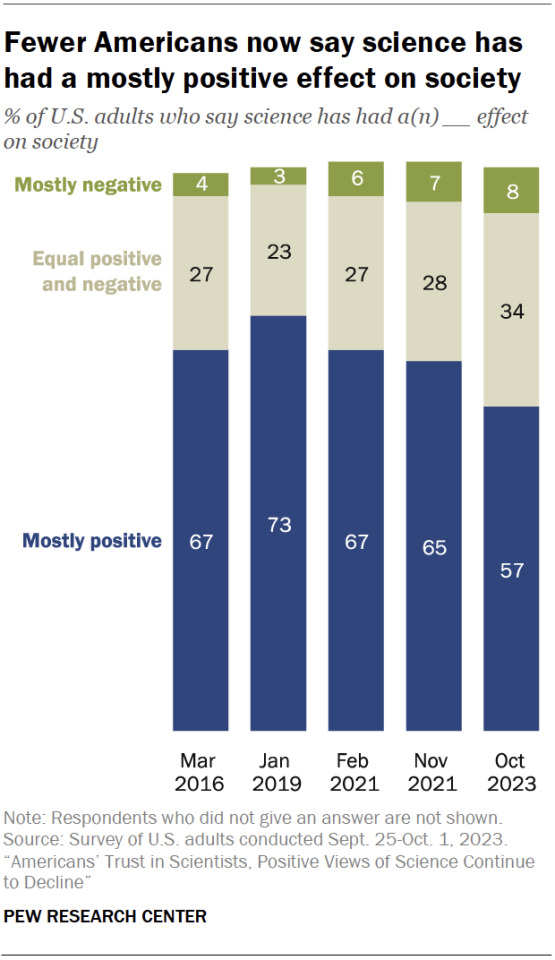
Trust in scientists
When it comes to the standing of scientists, 73% of U.S. adults have a great deal or fair amount of confidence in scientists to act in the public’s best interests. But trust in scientists is 14 points lower than it was at the early stages of the pandemic.
The share expressing the strongest level of trust in scientists – saying they have a great deal of confidence in them – has fallen from 39% in 2020 to 23% today.
As trust in scientists has fallen, distrust has grown: Roughly a quarter of Americans (27%) now say they have not too much or no confidence in scientists to act in the public’s best interests, up from 12% in April 2020.
Ratings of medical scientists mirror the trend seen in ratings of scientists generally. Read Chapter 1 of the report for a detailed analysis of this data.
How scientists compare with other prominent groups
The Center survey of 8,842 U.S. adults conducted Sept. 25-Oct. 1, 2023, finds that, despite recent declines in ratings, scientists and medical scientists continue to be held in high regard compared with other prominent groups in society. Smaller shares of Americans express confidence in business leaders, religious leaders, journalists and elected officials to act in the public’s best interests. As with scientists, most of these groups have seen their ratings decline in recent years.
Americans have expressed low trust in federal government and other institutions, like Congress, for decades. And political polarization – the widening gap between the views of Republicans and Democrats across a broad range of issues and attitudes – has come to be a dominant feature of American political life.
Differences between Republicans and Democrats in ratings of scientists and science
Declining levels of trust in scientists and medical scientists have been particularly pronounced among Republicans and Republican-leaning independents over the past several years. In fact, nearly four-in-ten Republicans (38%) now say they have not too much or no confidence at all in scientists to act in the public’s best interests. This share is up dramatically from the 14% of Republicans who held this view in April 2020. Much of this shift occurred during the first two years of the pandemic and has persisted in more recent surveys.
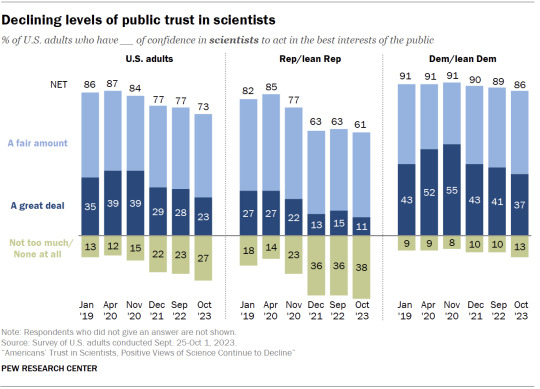
Confidence in scientists has also moved lower among Democrats. The share of Democrats and Democratic-leaning independents with a great deal of confidence in scientists – which initially rose in the pandemic’s first year – now stands at 37%, down from a high of 55% in November 2020. But unlike Republicans, a large majority of Democrats (86%) continue to express at least a fair amount of confidence in scientists to act in the public’s best interests. The overall differences in partisan views remain much more pronounced today than they were prior to the coronavirus outbreak.
One of the starkest illustrations of polarization in views of science is the drop in the share of Republicans who view the societal impact of science positively.
Fewer than half of Republicans (47%) now say that science has had a mostly positive effect on society. In 2019, 70% of Republicans said that science has had a mostly positive effect.
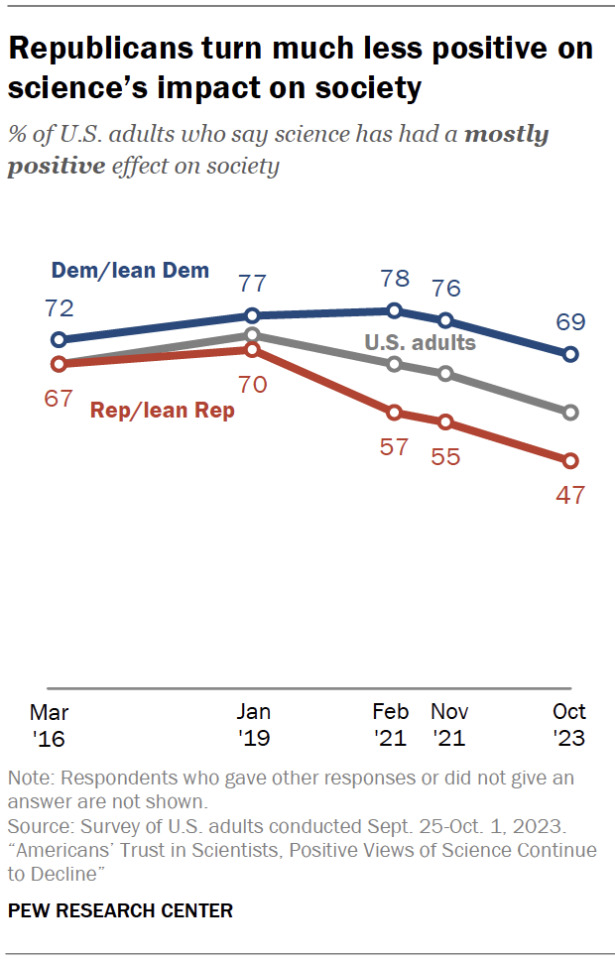
A majority of Democrats (69%) continue to say science has had a mostly positive effect on society, though this share is 8 points lower than it was in 2019.
Republicans were largely critical of the country’s response to the coronavirus outbreak. For instance, large shares said too little priority was given to respecting individuals’ choices, supporting businesses and economic activity, and meeting the needs of K-12 students. In addition, many Republicans felt that public health officials’ personal views had too much influence on policy and that officials were too quick to dismiss views that challenged their scientific understanding.
Government investments in science
Despite declines in ratings of scientists and science, a large majority of Americans continue to see government investments in science as worthwhile. And most place at least some importance on the United States being a world leader in scientific achievements.
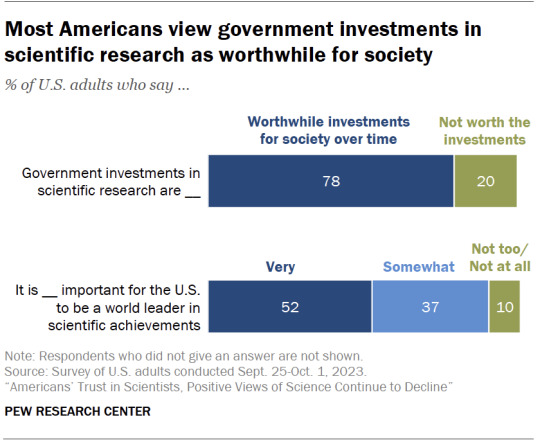
About eight-in-ten Americans (78%) say government investments in scientific research are usually worthwhile for society. Far fewer (20%) think these investments are generally not worthwhile. Large majorities across demographic and education groups see government investments in scientific research as worthwhile, as do large majorities of both Democrats and Republicans.
In addition, 52% of Americans think it is very important for the U.S. to be a world leader in scientific achievements; an additional 37% think this is somewhat important. These shares are more or less unchanged since last year.
Explore the rest of this report
• Confidence in scientists, medical scientists, and other groups and institutions in society (Chapter 1) ��� Views of the impact of science on society (Chapter 2) • Government investments in scientific research and the importance of the U.S. being a world leader in science (Chapter 3)
==
Ask them to hand in their phones, laptops and electric cars.
4 notes
·
View notes
Text
योगी सरकार ने 30 जून तक लगाई मास गैदरिंग पर रोक, सील रहेंगे बॉर्डर
योगी सरकार ने 30 जून तक लगाई मास गैदरिंग पर रोक, सील रहेंगे बॉर्डर
[ad_1]

Yogi Adityanath directs not allow any mass program till June 30
नई दिल्ली: कोरोना वायरस के बढ़ते कहर को देखते हुए उत्तर प्रदेश की योगी सरकार ने 30 जून तक मास गैदरिंग पर रोक लगा दी है। मुख्यमंत्री योगी आदित्यनाथ ने 30 जून तक ज्य़ादा लोगों के एक साथ जुटने पर रोक लगाने का निर्देश दिया है क्योंकि इससे कोरोना संक्रमण फैलने की पूरी सम्भावना है।…
View On WordPress
#corona cases in india#corona cases in up#corona cases in up live#corona cases in up today#up 25 april coronavirus news#UP Coronavirus#up coronavirus cases#up covid 19 cases#up covid 19 death news#up covid 19 latest news#up death cases covid 19#up first death covid 19#up lockdown extension#up lockdown latest news#Uttar Pradesh Hindi News#yogi aditya nath covid 19#yogi adityanath#yogi adityanath 30 june lockdown extension#yogi adityanath new guidelines#yogi adityanath on coronavirus
0 notes
Photo
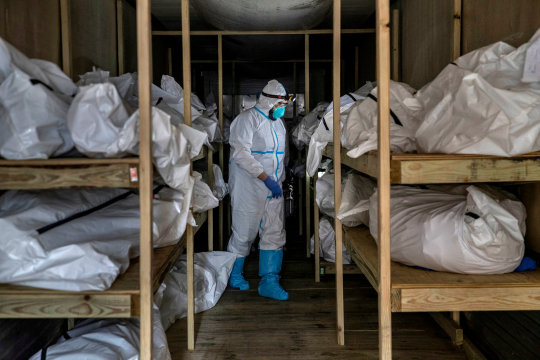


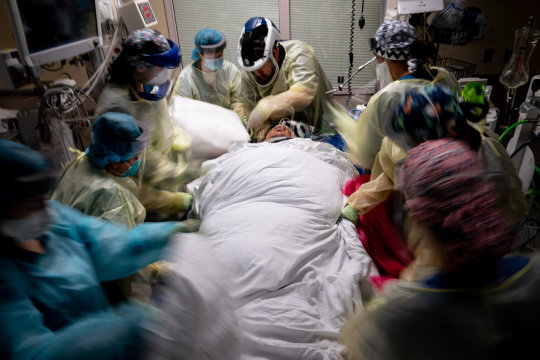

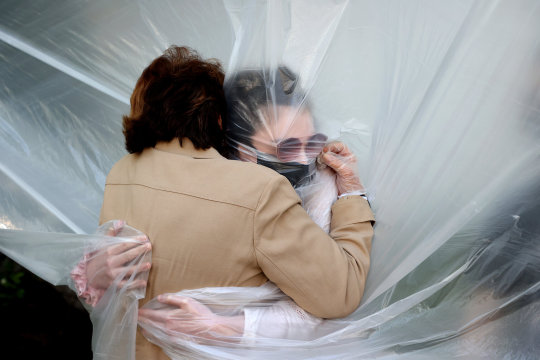

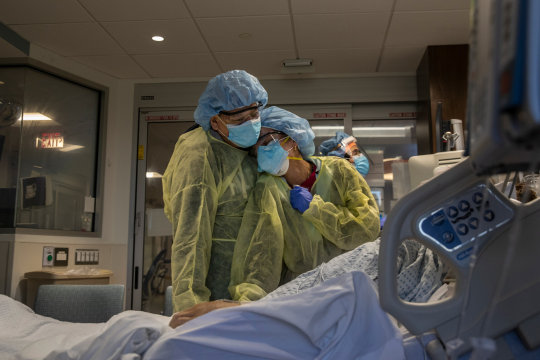
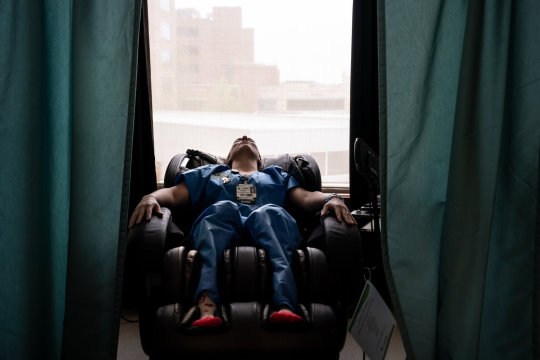

A Year Like No Other
1. Brooklyn, N.Y., April 20 Bodies were stacked in a refrigerated trailer at the Brooklyn Hospital Center. More than 20,000 New Yorkers died in the spring surge of coronavirus infections. Victor J. Blue for The New York Times
2. Queens, N.Y., April 1 Paramedics worked to resuscitate a coronavirus patient at a hospital. The borough emerged as the center of New York City’s raging outbreak. Philip Montgomery for The New York Times
3. Washington, Oct. 24 Suzanne Brennan Firstenberg set up over 220,000 white flags as part of an art installation outside the D.C. Armory to represent the nation’s death toll from the coronavirus at the time. Stefani Reynolds for The New York Times
4. Houston, July 15 A coronavirus patient on a ventilator at Houston Methodist Hospital. During the summer surge, the hospital created new virus wards, hired traveling nurses, and ramped up testing efforts. Erin Schaff/The New York Times
5. Mexico City, June 24 Workers burned the coffins of Covid-19 victims after their bodies had been cremated. Mexico had one of the highest coronavirus death tolls in the world. Marco Ugarte/Associated Press
6. Wantagh, N.Y., May 24 Olivia Grant hugged her grandmother, Mary Grace Sileo, through a plastic drop cloth hung on a clothesline. It was their first contact since the start of the lockdown caused by the pandemic. Al Bello/Getty Images
7. Manaus, Brazil, May 25 Rows of newly dug graves at a cemetery in Manaus, the Brazilian Amazon’s biggest city, where at one point every Covid-19 ward was full and 100 people a day were dying. Tyler Hicks/The New York Times
8. Manhasset, N.Y., April 19 Eliana Marcela Rendón was comforted by her husband, Edilson Valencia, as her grandmother, Carmen Evelia Toro, 74, lost her battle against Covid-19 at a hospital on Long Island. Victor J. Blue for The New York Times
9. Newark, Del., April 30 A nurse took a moment in a massage chair in an “oasis” room at Christiana Hospital, set up to give stressed medical workers a breather. Erin Schaff/The New York Times
10. Coventry, England, Dec. 8 Medical workers cheered for Margaret Keenan, 90, after she became the first person in Britain to receive the coronavirus vaccine developed by Pfizer and BioNTech. “I feel so privileged,” she said. Pool photo by Jacob King
6K notes
·
View notes